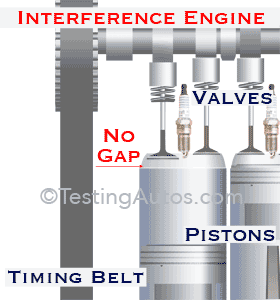When it comes to automotive engineering, not all engines are created equal. One of the most crucial distinctions made in this domain is between interference and non-interference engines. Understanding the mechanics of an interference engine is essential for both car enthusiasts and everyday drivers, especially when considering the implications of engine design on performance and maintenance. In this article, we delve into the intricate workings of interference engines and explore their benefits and drawbacks.
What is an Interference Engine?
An interference engine is a type of internal combustion engine where the pistons and valves occupy the same space in the cylinder at different times. In simpler terms, this means that if the timing of the engine is off, the pistons can collide with the valves, leading to catastrophic damage. This is a critical design feature that distinguishes interference engines from their non-interference counterparts, where such collisions are physically impossible due to design constraints.
The Mechanics Behind Interference Engines
To appreciate how interference engines operate, one must first understand the basic mechanics of an engine’s timing system. The timing belt or chain is responsible for synchronizing the rotation of the crankshaft and camshaft. In an interference engine, precise timing is crucial. Here’s a breakdown of how it works:
- Pistons and Valves: As the engine cycles through its four strokes (intake, compression, power, and exhaust), the pistons move up and down while the valves open and close to allow fuel and air in and exhaust out.
- Timing Mechanism: The timing belt or chain ensures that the valves open and close at the right moments. If this timing is disrupted due to wear or failure, the potential for the pistons to hit the valves increases significantly.
- Clearance: The term ‘interference’ refers to the lack of clearance between the pistons and valves. In a non-interference engine, there is sufficient space to prevent any possibility of collision, while in interference engines, a misalignment can lead to serious consequences.
Implications of Interference Engine Design
The interference engine design has several implications for vehicle performance, maintenance, and repair:
Pros of Interference Engines
- Performance: Interference engines typically have higher compression ratios, which can lead to increased power output and better efficiency.
- Compact Design: The design allows for a more compact engine layout, which can save space and weight in vehicle construction.
- Cost-Effectiveness: Many interference engines are used in performance-oriented vehicles, making them a popular choice among manufacturers aiming for sporty handling and speed.
Cons of Interference Engines
- Risk of Damage: The primary drawback is the potential for catastrophic engine damage. If the timing belt fails, it can lead to bent valves, damaged pistons, and costly repairs.
- Maintenance Needs: Regular maintenance is crucial. Timing belts or chains must be replaced at recommended intervals to prevent failure.
- Repair Costs: If a collision occurs, the repair costs can be significantly higher compared to non-interference engines due to the extensive damage that can occur.
Understanding interference engines is vital for anyone involved in automotive repair or performance tuning. While they offer advantages in terms of power and efficiency, the risks associated with potential damage cannot be overlooked. Regular maintenance and timely replacement of timing components are essential to ensuring the longevity and reliability of these engines. As technology advances, manufacturers continue to refine engine designs, but the fundamental mechanics of interference engines remain a critical aspect of automotive engineering.










I loved how this article broke down complex concepts into digestible parts. Understanding interference engines has never been easier!
I never realized how critical timing is in an interference engine. This article opened my eyes to potential maintenance issues I need to watch out for.
This article provided a clear and concise explanation of interference engines. I learned so much about the importance of timing in engine performance!
This piece is a must-read for anyone interested in automotive engineering. The insights on performance implications were particularly valuable.
Fantastic article! The way it explained the mechanics behind the timing system was very helpful. I now feel more confident discussing engine types.
Great read! The comparison between interference and non-interference engines really helped me grasp their differences. Highly recommend this for car enthusiasts!
I appreciate the detailed breakdown of how interference engines work. The mechanics section was particularly informative and easy to understand.